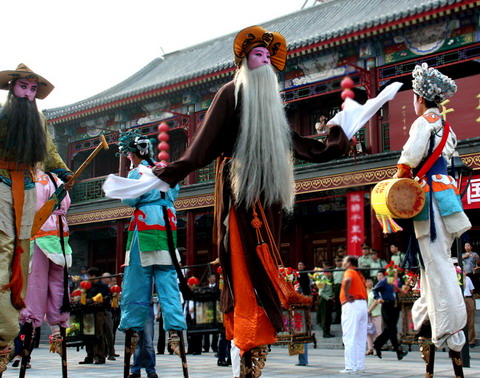Walking on the Stilts
踩高跷
A stilt is made by fitting a footrest on a long stick.People tread on the treadles.tie the stilts onto the legs, then walk on the stilts and make movements. This is called Walking on Stilts.
在一根长长的木棍上,装上脚踏板,便形成了一支高跷;人们把脚分别踩在两支高跷的脚踏板上,再把高跷绑在腿上,利用高跷行走并做各种动作,就称为踩高跷。
During the period of Wei, Jin, the Southern and the Northern dynasties, walking on Stilts was performed in the imperial palace mainly as a game of acrobatics. It was spread among the people offer Song and Yuan dynasties.
魏晋南北朝时期,踩高跷主要是作为一种杂技项目在宫中表演的,至宋元以后,踩高跷活动才开始在民间普及开来。
The folk stilts performance is usually done in the festivals such as the Spring Festival and the Double Ninth Festival.
民间的高跷表演,通常在春节、重阳登高等传统节日进行。

In order to make the performance more attractive, people usually mix the traditional dramas with stilts. Walking on Stilts can be divided into civil and military.
为了使高跷表演更具吸引力,人们常把传统戏曲与踩高跷技术结合起来。而且,有人还根据高跷表演的特点,把高跷分为文跷与武跷两种。
The civil stilts means to act the roles in dramas, such as the roles of Tang Seng and his apprentices in the “Journey to the West” and Xu Xian and Lady Bai in the“Legend of the White Snake” and so on.
所谓文跷,就是以扮演戏曲中的角色为主,诸如《西游记》中的唐僧师徒,《白蛇传》中的许仙、白娘子等;
The military stilt means to act the unique skills such as leap in the air and rolls etc. which reflects the characteristics of Walking on Stilts.
所谓武跷,则以表演高跷绝技如腾空跳跃、大翻飞等等为主,最能反映踩高跷活动的特色。
Walking on the stilts is a living activity. Even at present,the stilts team could be seen at the fairs or the performances in the traditional festivals.
踩高跷是一项极具生命力的活动。即使在今天,每当欢庆传统佳节之时,都会在各种庙会、演出中看到高跷队的身影。
So to speak, Walking on Stilts has become an important Chinese cultural symbol like the Dragon dance, Lion dance and Yangko dance.
可以说,踩高跷与耍龙灯、舞狮子、扭秧歌一样,己经成为中华民族文化的一个重要象征。